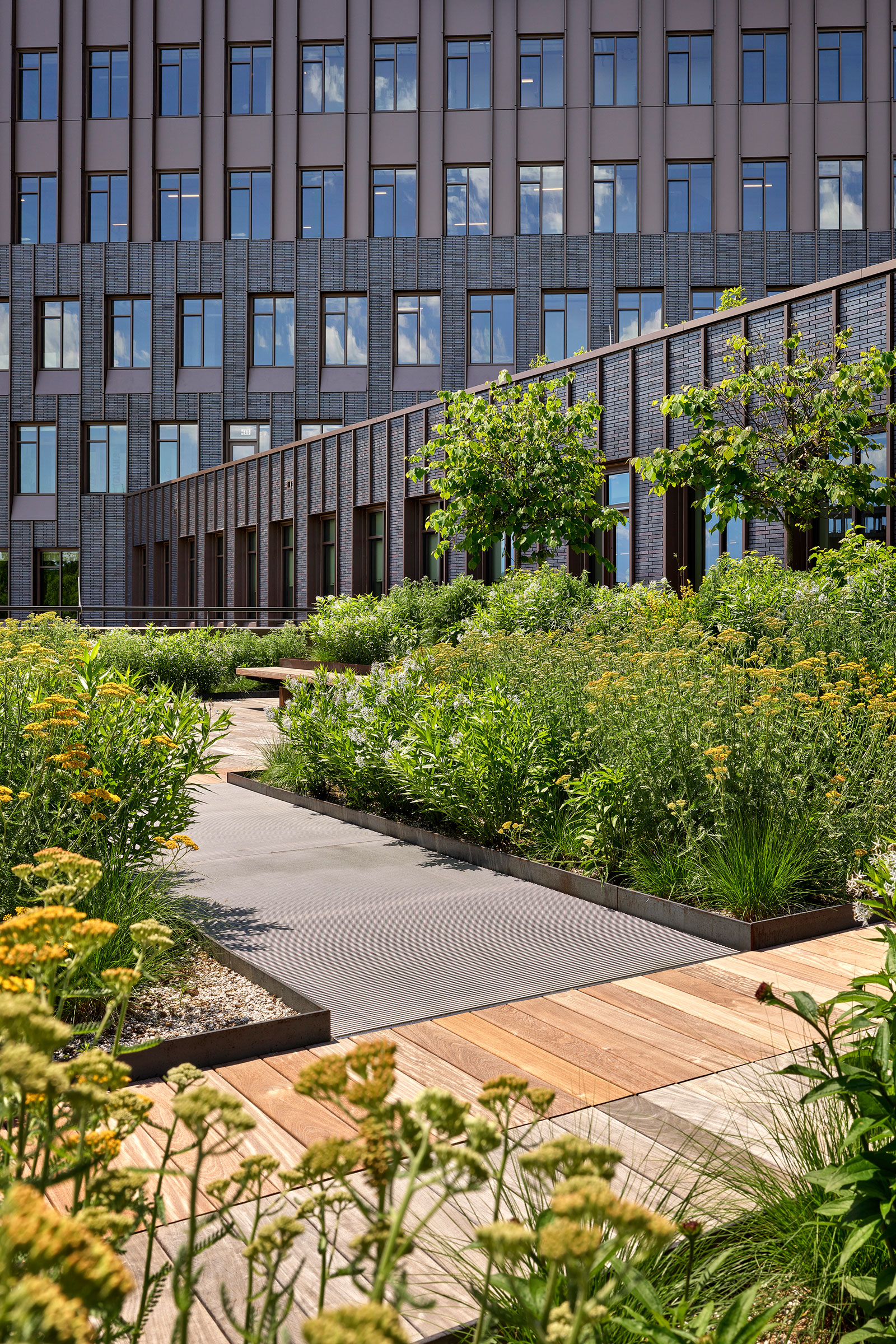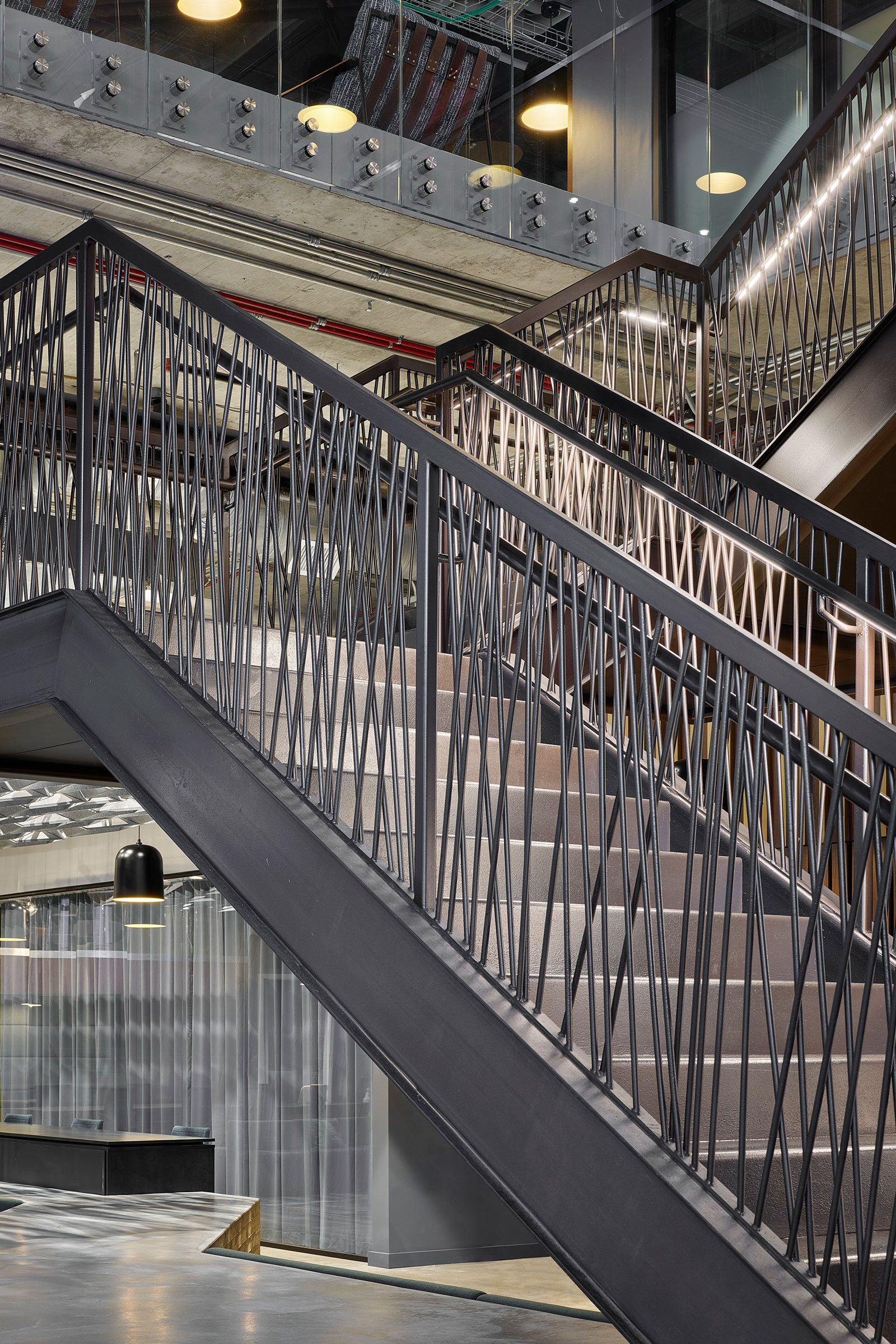Story at a glance:
- The LEED Platinum–certified Center of Developing Entrepreneurs is a new mixed-use project in Charlottesville that creatively combines coworking and retail.
- EskewDumezRipple worked on this project to make it feel more like home while celebrating green living.
When the design team at EskewDumezRipple got to work on a new mixed-use project in Charlottesville, Virginia, they knew it needed to serve as an inviting front door to the downtown mall.
“CODE was designed to act as a highly visible beacon to the Charlottesville community,” says Jose Alvarez, principal architect at EskewDumezRipple.
The Center for Developing Entrepreneurs, or CODE, was designed to be a place where locally grown innovations in information technology and clean energy could grow into locally based businesses rather than relocate.
The project’s design is warm and walkable, with nods to nature at every turn. The building itself traverses a steep surrounding incline, and the design team carried this notion through to the interiors—carving away at materials or revealing them as the building is similarly carved into and extruded from the earth. “Various program elements celebrate these different layers, like the layers of earth and stone that build up over time and are revealed through excavation,” Alvarez says.
The color palette is also inspired by the earthy tones and metals found on the ground, with bronze metal colors, charcoal textures, and warm wood tones.
Challenges
- Brick is the main material in the downtown mall, and by utilizing metal fins and brick paneling the design team reproduced the familiar rhythm found in the mall architecture. Photo by Alan Karchmer
- Photo by Alan Karchmer
Walkability was among the project’s biggest challenges, Alvarez says, as the team wanted to locate CODE on the pedestrian mall.
The team decided to stair-step up from the mall toward the intersection of Main and Water streets, spiral up further to meet the scale of Water Street, then design a cascade of occupiable terraces and green roofs.
Throughout the design they performed simulations not just for their impact on energy consumption but also to examine the impact of shadows that would be cast. “The spiraling form also generates a courtyard that is simultaneously inviting for pedestrians and yet provides a feeling of enclosure with a water feature at its center.”
The next challenge was to make the extremely topographical site universally accessible. “The solution was to include a sizable public plaza space with low sloping planes to accommodate ADA accessibility throughout the plaza and provide accessible connections between different site elevations,” Alvarez says.
Sustainability
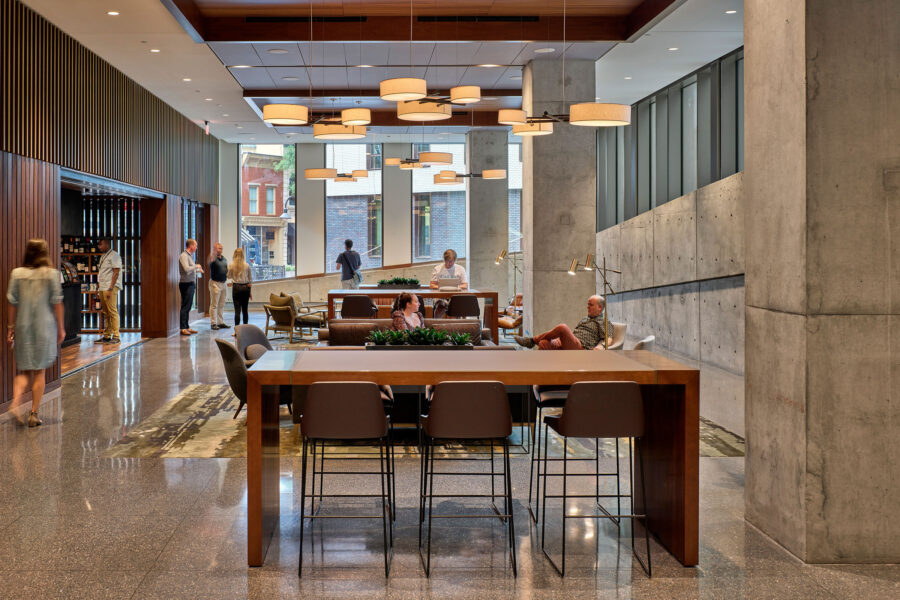
CODE was designed to employ systems and technologies beyond even LEED standards. Photo by Alan Karchmer
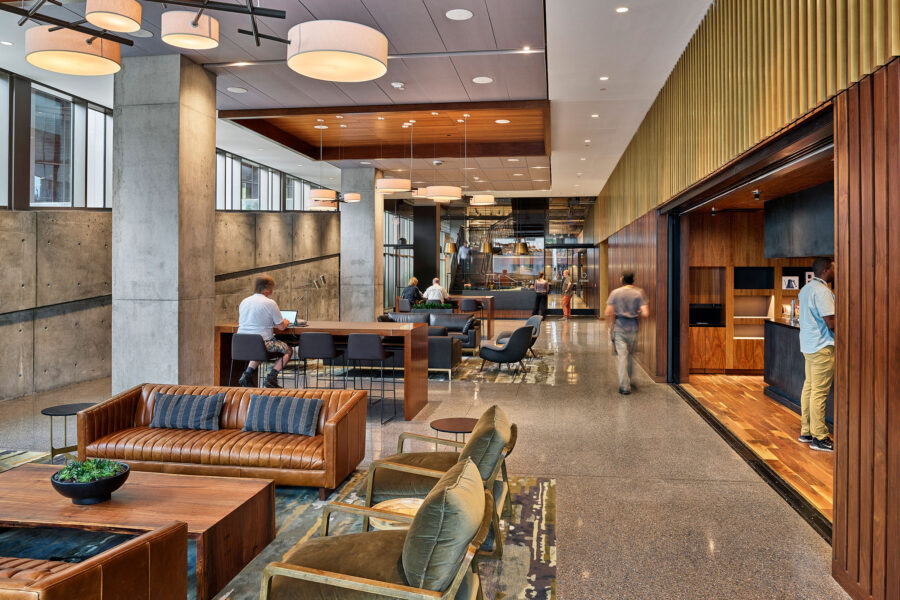
Photo by Alan Karchmer
Throughout the project the design team assessed carbon emissions associated with the materials used for construction, helping the team lower the carbon footprint of the project even before the building opened.
CODE was designed to deliver an indoor working environment informed by the latest research results on how air quality, daylight, and views impact human cognitive function. They achieved this with an energy use intensity about one-third that of typical office buildings, helping the building achieve LEED Platinum.
“Green building decisions often prove to be the healthiest decisions for those who will use the building the most,” Alvarez says. “The sustainable intentions of the project were important for the project to provide both performance-enhancing features for the environment and the workers it hosts.”
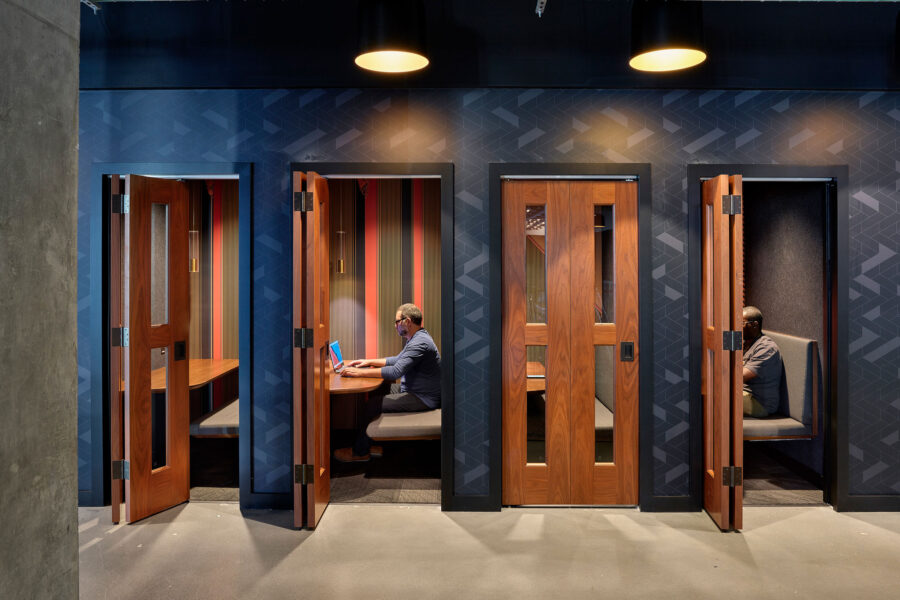
Photo by Alan Karchmer
The building envelope design draws from the brick cladding and punched window openings of the historic context but is implemented with a modern rainscreen to achieve high levels of insulation and thermal comfort while protecting against water intrusion.
“The story of this project illustrates the way our team works,” Alvarez says. “Draw from the vernacular, reinterpret to modern needs and methods, test design concepts with simulation against goals based on the latest in research, and deliver a result that bridges from past to future with a superior environment for occupants and superior environmental performance.”
The team chose materials with low emissions throughout, and the building ventilation system provides more than twice the standard flow of fresh air—and in ways that still achieves energy use that is one-third that of the benchmark office building.
“We also love the self-shading feature of the inset windows and the articulation of the facade materials as the building negotiates the site slopes and historic context.”
Coworking & Community

The project was designed to increase the fresh air exchange and provide fine-tuned environmental controls for natural ventilation and daylighting. Photo by Alan Karchmer
The design team researched coworking spaces extensively, visiting various facilities to find the best balance, especially as coworking continues to experience rapid development and innovation, Alvarez says.
“The design team worked with a client representative in pursuing a vision to uphold the changing nature of work, straddling a line between the formal and informal, instilling a unique blend of clean commercial space with a more relaxed residential feel,” he says. “All interior elements, from furniture and textiles to fixtures and artwork, were handpicked by the team in fostering a warm, welcoming space.”
The office’s communal elements were designed to stand out from each other, while private offices were more standardized—furthering the notion that most people would gravitate to the communal spaces they found most pleasing, Alvarez says.
“Early on the layout and circulation were planned to encourage crosses between the public, the coworking tenants, and the private office users, facilitating conversation and connection between different users and working to balance the vibrance and fun of a coworking space with the formality and professionalism of world-class office and auditorium space.”
That feeling of community continues outside, with an “outdoor workplace” experience among green roofs. The cascading green roofs cover eight garden roofs—an amenity to tenants and visitors but also a benefit to visiting birds, insects, and pollinators of all kinds, Alvarez says. The rooftop terraces and gardens support more than 90 distinct species, including more than 7,000 perennials and grasses, 100 shrubs, and 75 large trees, many of which are native. The roof also captures rainwater that is then stored in two underground cisterns and used to irrigate the plants.
Today the project is 100% leased and the coworking space has a waiting list. “The plaza space is being constantly activated by community events and pedestrian mall gatherings,” Alvarez says. “It is exciting to see the benefits that the project has brought to downtown Charlottesville—and how the power of design can bring a sense of place to a community.”
- More than 30% of the site is covered in native plants. Photo by Alan Karchmer
- Photo by Alan Karchmer
Project Details
Project: Center of Developing Entrepreneurs (CODE)
Location: Charlottesville
Completion: 2022
Size: 215,000 square feet
Architect: Wolf Ackerman
Associate Architect: EskewDumezRipple
Structural Engineer: Fox & Associates
Civil Engineer: Timmons Group
MEP Engineer: 2RW
Interior Design: EskewDumezRipple
General Contractor: Hourigan
Lighting Design: DKT Lighting
Landscape Architect: Gregg Bleam Landscape Architect
Sustainability: STRUCTR Advisors
Energy Modeling: Thornton Tomasetti
Certifications & Awards: LEED Platinum, 2023 AIA National Architecture Award
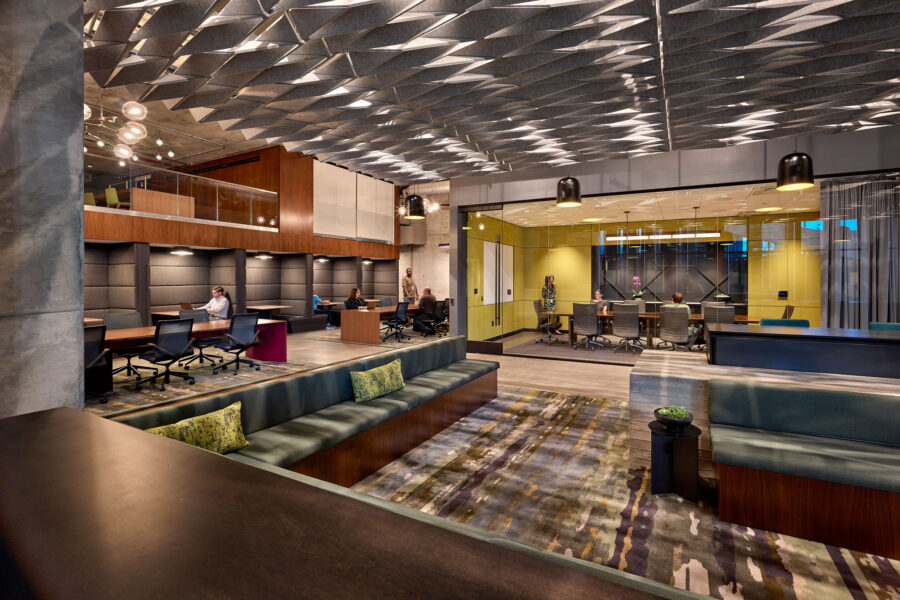
Ceiling designs at CODE include product from Arktura and Hunter Douglas. Carpets by Bentley. Photo by Alan Karchmer







